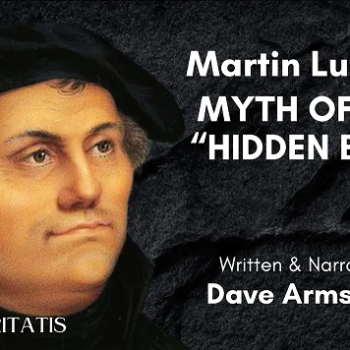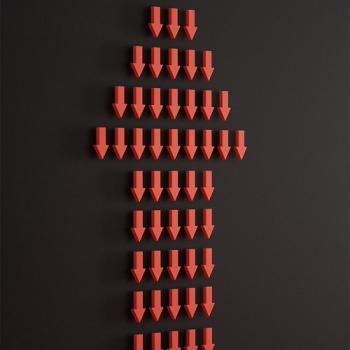
Atheist and anti-theist Bob Seidensticker, who was “raised Presbyterian”, runs the influential Cross Examined blog. He asked me there, on 8-11-18: “I’ve got 1000+ posts here attacking your worldview. You just going to let that stand? Or could you present a helpful new perspective that I’ve ignored on one or two of those posts?” He also made a general statement on 6-22-17: “Christians’ arguments are easy to refute . . . I’ve heard the good stuff, and it’s not very good.” He added in the combox: “If I’ve misunderstood the Christian position or Christian arguments, point that out. Show me where I’ve mischaracterized them.”
Such confusion would indeed be predictable, seeing that Bob himself admitted (2-13-16): “My study of the Bible has been haphazard, and I jump around based on whatever I’m researching at the moment.” I’m always one to oblige people’s wishes if I am able, so I decided to do a series of posts in reply. It’s also been said, “be careful what you wish for.” If Bob responds to this post, and makes me aware of it, his reply will be added to the end along with my counter-reply. If you don’t see that, rest assured that he either hasn’t replied, or didn’t inform me that he did. But don’t hold your breath.
Bob (for the record) virtually begged and pleaded with me to dialogue with him in May 2018, via email. But by 10-3-18, following massive, childish name-calling attacks against me, encouraged by Bob on his blog (just prior to his banning me from it), his opinion was as follows: “Dave Armstrong . . . made it clear that a thoughtful intellectual conversation wasn’t his goal. . . . [I] have no interest in what he’s writing about.”
And on 10-25-18, utterly oblivious to the ludicrous irony of his making the statement, Bob wrote in a combox on his blog: “The problem, it seems to me, is when someone gets these clues, like you, but ignores them. I suppose the act of ignoring could be deliberate or just out of apathy, but someone who’s not a little bit driven to investigate cognitive dissonance will just stay a Christian, fat ‘n sassy and ignorant.” Again, Bob mocks some Christian in his combox on 10-27-18: “You can’t explain it to us, you can’t defend it, you can’t even defend it to yourself. Defend your position or shut up about it. It’s clear you have nothing.” And again on the same day: “If you can’t answer the question, man up and say so.” And on 10-26-18: “you refuse to defend it, after being asked over and over again.” And again: “You’re the one playing games, equivocating, and being unable to answer the challenges.”
Bob’s cowardly hypocrisy knows no bounds. Again, on 6-30-19, he was chiding someone who (very much like he himself) was (to hear him tell it) not backing up his position: “Spoken like a true weasel trying to run away from a previous argument. You know, you could just say, ‘Let me retract my previous statement of X’ or something like that.” Yeah, Bob could! He still hasn’t yet uttered one peep in reply to — now — 36 of my critiques of his atrocious reasoning. As of 7-9-19, this is how Bob absurdly rationalizes his non-response: “He’s written several blog posts titled, in effect, ‘In Which Bob Seidensticker Was Mean to Me.’ Normally, I’d enjoy a semi-thoughtful debate, but I’m sure they weren’t.”
Bible-Basher Bob’s words will be in blue. To find these posts, word-search “Seidensticker” on my atheist page or search “Seidensticker Folly #” in my sidebar search (near the top).
*****
Bob’s article, “BSR [Bite-Sized Reply] 5: The Bible Is Full of Contradictions” (3-30-20) is a classic case study of a fool hypocritically lecturing us supposedly ignorant, imbecilic Christians as to what a supposed logical contradiction is, when in fact he doesn’t have a clue himself. I suggest that he get up to speed on his elementary logic before attempting further articles of this nature:
Law of noncontradiction (Wikipedia)
Syllogism (Wikipedia)
Deductive reasoning (Wikipedia)
Fallacy (Wikipedia)
Let’s run through a few Bible contradictions and consider what real eyewitness testimony would look like.
Yeah, let’s . . .
(These Bite-Size Replies are responses to “Quick Shots,” brief Christian responses to atheist challenges. The introduction to this series is here.)
Challenge to the Christian: The Bible is full of contradictions.
Bite-Size Reply: No it ain’t!
Christian response #1: There’s a difference between a contradiction and a variation. Two reports about the same thing may not be identical, but that doesn’t mean they contradict.
Amen!
The gospels all have women telling the disciples about the empty tomb, except for Mark. In that gospel, the women are told by a man in the tomb to report the resurrection to the disciples. But “trembling and bewildered, the women went out and fled from the tomb. They said nothing to anyone, because they were afraid.” And there Mark ends. That’s a contradiction.
Not at all. What Bob has done is assume that 16:8 is the end of the book. It’s true that there is a dispute over the authenticity of verses 9-20 as part of the biblical canon, and many modern biblical scholars agree with Bob that it is not. But then again, one can find in modern biblical scholars belief (or non-belief) in just about anything. It’s a radically mixed bag, and everyone has their starting premises, which may be and are questioned.
In the long version, Mary Magdalene (referred to in verse 1, as visiting the tomb) tells the disciples that she had seen the risen Jesus (16:9-11). Dr. Dave Miller wrote a superb, gloriously in-depth article, “Is Mark 16:9-20 Inspired?” Apologetics Press, 2005). Here are a few key excerpts (line breaks mean a break in the text):
Most, if not all, scholars who have examined the subject concede that the truths presented in the verses are historically authentic—even if they reject the genuineness of the verses as being originally part of Mark’s account. The verses contain no teaching of significance that is not taught elsewhere. [followed by numerous examples]
Those who reject the originality of the passage in Mark, while acknowledging the authenticity of the events reported, generally assign a very early date for the origin of the verses.
[T]he sheer magnitude of the witnesses that support verses 9-20 cannot be summarily dismissed out of hand. Though rejecting the genuineness of the verses, the Alands offer the following concession that ought to give one pause: “It is true that the longer ending of Mark 16:9-20 is found in 99 percent of the Greek manuscripts as well as the rest of the tradition, enjoying over a period of centuries practically an official ecclesiastical sanction as a genuine part of the gospel of Mark” (1987, p. 287, emp. added). Such longstanding and widespread acceptance cannot be treated lightly nor dismissed easily.
The patristic writings that indicate acceptance of the verses as genuine are remarkably extensive. From the second century, Irenaeus, who died c. A.D. 202, alludes to the verses in both Greek and Latin. [a host of other examples follows]
All told, the cumulative external evidence that documents the genuineness of verses 9-20, from Greek manuscripts, patristic citations, and ancient versions, is expansive, ancient, diversified, and unsurpassed.
Here’s another. The second Commandment against worshiping idols has this: “I, the Lord your God, am a jealous God, punishing the children for the sin of the parents to the third and fourth generation of those who hate me” (Exodus 20:5). In a more sober frame of mind in a later book, God changed his mind: “Fathers shall not be put to death for their children, nor children put to death for their fathers; each is to die for his own sin” (Deuteronomy 24:16). That’s a contradiction.
It’s not. I already refuted this contention of Bob’s over a year-and-a-half ago: Seidensticker Folly #17: “to the third and fourth generations”? [9-11-18] Readers will, no doubt, be utterly shocked to learn that he never offered any counter-reply to it. So here he is, asserting the same tired argument that has long since been refuted. As Proverbs 9:8 (RSV) states: “Do not reprove a scoffer, or he will hate you; reprove a wise man, and he will love you.” 29:1 adds: “He who is often reproved, yet stiffens his neck will suddenly be broken beyond healing.”
There are thick books like The Big Book of Bible Difficulties that have rationalizations for hundreds of cases like these, . . .
Precisely because there are thick anti-theist atheists like Bob, there is a need to compile thick books that thoroughly refute their endless fallacious and false contentions. That doesn’t prove in the slightest that the Bible is full of contradictions: only that (once all the evidence is in) its critics are. Hence, this is my 37th refutation of Bob’s claims, which would probably add up to at least a small book. Also, I observed in my paper, Why We Should Fully Expect Many “Bible Difficulties” (4-5-19):
1. The Bible is a very lengthy, multi-faceted book by many authors, from long ago, with many literary genres (and in three languages), and cultural assumptions that are foreign to us.
2. The Bible purports to be revelation from an infinitely intelligent God. Thus (even though God simplifies it as much as possible), for us to think that it is an easy thing to immediately grasp and figure out, and would not have any number of “difficulties” for mere human beings to work through, is naive. The Bible itself teaches that authoritative teachers are necessary to properly understand it.
3. All grand “theories” have components (“anomalies” / “difficulties”) that need to be worked out and explained. For example, scientific theories do not purport to perfectly explain everything. They often have large “mysterious” areas that have to be resolved.
Here’s what eyewitness testimony looks like: “I Simon Peter and Andrew my brother took our nets and went to the sea” (from the Gospel of Peter). “I Thomas, an Israelite, write you this account” (the Infancy Gospel of Thomas). “These are the secret sayings which the living Jesus spoke and which Didymos Judas Thomas wrote down” (the Gospel of Thomas). But this is apparently unconvincing because these books aren’t in the New Testament! And Matthew, Mark, Luke, and John have no clear, identified eyewitness claims like these.
Oh, that’s cute. In writing a piece criticizing the Bible, Bob then introduces three passages from spurious late and Gnostic-influenced Gospels that were never accepted into the canon of Scripture. He (big surprise!) finds them superior in quality. David Heady, in his article, “The Gospels of Judas, Peter, and Thomas: Is Their Exclusion from the Canon Merited?” (2016) writes, concerning the Gospel of Peter:
No small amount of literature has been written pertaining to the apocryphal gospel of Peter. While a few attempts have been made to place its date of origin into the first century, they have generally been met with great resistance from scholars of a wide variety. Bart Ehrman states, “There are reasons for dating the text to a period after the canonical Gospels, probably sometime in the beginning or middle of the second century.”24 . . . Paul Foster goes even further by affirmatively stating, “Theories that attempt to press the text of the Gospel of Peter, or a source embedded within it, back into the first century are not sustainable. The text is best understood as a reflection on canonical traditions, and it also demonstrates theological trajectories that are part of later Christianity.”26 Hence, it would appear that the gospel of Peter could not have been written by someone who had walked with Christ or who had interviewed someone who had.
24 Bart D. Ehrman and Zlatko Plese. Apocryphal Gospels: Texts and Translations (Oxford, New York: Oxford University Press, 2011), 376.
26 Paul Foster, “The Gospel of Peter,” The Expository Times 118, no. 7 (July, 2016): 324.
Its not enough for a reputed “Gospel” to simply state, “I Simon Peter . . . ” Anyone can claim to be anyone. Such books have to be proven to be early enough to have been eyewitness testimony as well. This one simply doesn’t pass the smell test. As for the Gospel of Thomas, David Heady noted:
As is the case with Peter and Judas, the general consensus is that Thomas originated in the mid-to-late second century. . . . It would be the only book in the canon to have a date of origin that is not just in the second century but is well into it. . . .
Kruger points out, “The broad consensus is that Thomas was written. . . by an unknown author (certainly not the apostle Thomas).” [Michael J. Kruger, Canon Revisited: Establishing the Origins and Authority of the New Testament Books (Wheaton, IL: Crossway, 2012), 328]
Likewise, James Bishop in his article, “Jesus and the Infancy Gospel of Thomas: What Do We Know?” (3-23-20), writes:
The IGT was probably written in Greek at some point in the late second century CE. It is not therefore considered an early source for the historical Jesus as it is removed by well over a century. Like the apocryphal Gospel of Thomas, the IGT claims its contents consist of the “stories of Thomas the Israelite”, hence from the original disciple himself. However, scholars are in agreement that this is not the case.
So much for Bible-Basher Bob’s rather novel brand of so-called “eyewitness testimony.”
***
Related Reading
*
Alleged “Bible Contradictions”: Most Are Actually Not So [2002 and 6-7-17]
*
*













